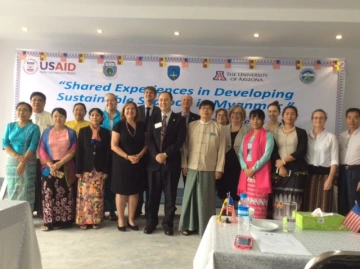
Aug. 28, 2017
By Shane Burgess, University of Arizona Vice President for Agriculture, Life and Veterinary Sciences, and Cooperative Extension
Finding employees who can lead teams and work well as part of a team is a top priority for companies today. In higher education as well, teams outperform individuals in the creative pursuits of scientific knowledge generation1, education2 and extending knowledge to our communities.
Like the best companies, we must value creativity to be successful, and thought-diverse teams are especially creative. But thought diversity is also challenging. With thought diversity comes personality diversity, and thought-diverse teams have longer start-up times and require greater leadership.
I believe these outcomes are well worth the effort and so I encourage everyone to reach out and across our very thought-diverse college (as well as the UA as a whole) to partner and to think bigger. UA truly does have “low walls between our administrative silos;” this is an “unfair advantage” and we should build on it. Here are two really great examples. Please send your examples to Heather Roberts-Wrenn (hrobertswrenn@email.arizona.edu) and we’ll share them in future.
Lisa Shubitz (School of Animal and Comparative Biomedical Sciences) and Marc Orbach (School of Plant Sciences) are an exemplary “One Health” team, already a thought-diverse concept in itself. Lisa and Marc were just awarded $4.8M from the National Institutes of Health to work on a Valley Fever vaccine model for human health, and at the same time taking the vaccine to market to prevent Valley Fever in dogs. Our dog, Manny, contracted Valley Fever and almost died. He is now on a very long therapeutic regimen. He is getting well because our family can afford his expensive medication. But many families simply couldn’t afford to treat their pet. A Valley Fever vaccine will save beloved animal and human family members from suffering, grief and expense.
Over the summer, I was honored to see another thought-diverse team of CALES faculty in action across the globe in Myanmar. The team included Kevin Fitzsimmons (Department of Soil, Water and Environmental Science) and Jeannie McLain (Water Resources Research Center), UA faculty Linda Chu and Julianne Hammink (Center for English as a Second Language) and Josephine Korchmaros (Southwest Institute for Research on Women), U Soe Tun, chief of party (Sustainable Seafood Industry Development Project), and Kay Lwin Tun, professor of zoology at Yangon University. Under contract to USAID, this very thought-diverse team has implemented Myanmar’s first Sustainable Seafood Industry Development Project, including diagnostic laboratories. This team, who didn’t even share a common language throughout the project, have created new job opportunities for thousands of Burmese. It has also opened the possibility for us to grow our education opportunities and so global awareness in our students.
[1] Benjamin F. Jones, et al, “Multi-University Research Teams: Shifting Impact, Geography, and Stratification in Science,” Science 322 (2008): 1259-1262. Stefan Wuchty, et al, “The Increasing Dominance of Teams in Production of Knowledge,” Science 316 (2007), 1036-1039. Stefan Wuchty, et al, “Response,” Science 317 (2007), 1497-1498.
[2] John R. Curry, et al, Responsibility Center Management: A Guide to Balancing Academic Entrepreneurship with Fiscal Responsibility (NACUBO, 2013).
Media contact:
Bethany Rutledge, director of administration and communications
520-621-7198, rutledge@cals.arizona.edu

